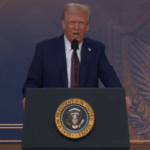As inflation and interest rates pinch wallets in Washington, D.C., families are eyeing global trends to make sense of their budgets, from grocery bills to mortgages. A new IMF tracker reveals stark differences across nations, with the U.S. grappling with 3.2% inflation and 5% rates, while Europe and Asia face their own battles. For locals, the data hits home, but critics question if central banks, including the Fed, are too slow to ease the pressure, leaving households to navigate a rocky economic road.
The IMF’s 2025 Economic Outlook shows U.S. inflation cooling from 2024’s 4.1% but outpacing the Eurozone’s 2.1%, where the ECB cut rates to 3.25% in April, per ECB data. Japan’s 2.5% inflation and 0.25% rates reflect cautious easing, while China’s 1.8% prices and 3.5% rates signal stimulus. Turkey battles 45% inflation, with 50% rates, per IMF, squeezing its middle class. In D.C., the Fed’s 5% rate, unchanged since mid-2024, keeps mortgages at 7.3%, up from 3.6% in 2022, per Freddie Mac. “Our grocery bill’s up 20%,” said Clara Vong, a Foggy Bottom teacher. “Saving’s impossible.”
Global disparities shape local lives. “Europe’s lower rates sound nice, but their taxes are brutal,” said Mike Ellis, a Bethesda retiree. Small D.C. cafes face 15% ingredient cost hikes from tariffs, while homebuyers delay purchases, with 30% fewer sales, per Redfin. Analyst Rajiv Patel said, “The Fed’s hawkish stance fights inflation but stalls growth—Europe’s easing faster.” A June 2025 poll shows 65% of D.C. residents feel inflation’s bite, but 50% distrust rate cuts, fearing price spikes.
The U.S.’s $27 trillion economy faces 1.5% growth, lagging China’s 4.5%, per IMF. Eurozone’s 1% growth, hit by Germany’s industrial slump, contrasts southern Europe’s tourism boom. High U.S. rates curb hiring, with 20% fewer D.C. job postings, per Indeed. Critics argue the Fed’s 2% target ignores real pain, as 40% of Americans dip into savings, per a 2024 APA survey. Globally, trade tensions and 30% Chinese import tariffs could add 1% to inflation, per ECB, hitting small retailers hardest.
The Fed eyes a July rate cut if inflation dips to 2.8%, while the ECB targets 2% by 2026. D.C. families like Vong’s hold on, hoping for relief. “We’re cutting date nights to pay bills,” she said. As nations juggle rates and prices, the tracker offers clarity, but for locals, the question remains: when will the squeeze loosen?web:3,4,5,13,17,18,22,23,24




















